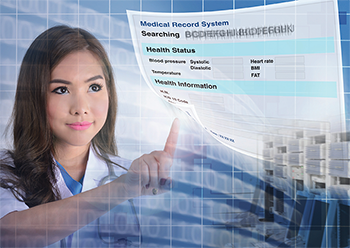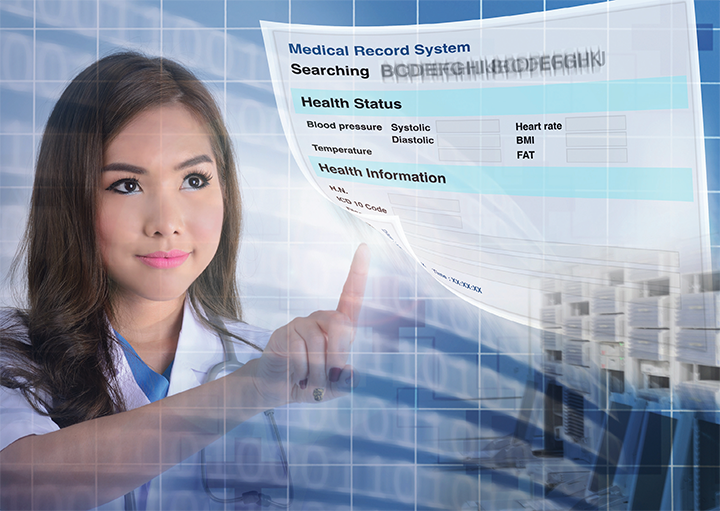Informatics nurses increase efficiency, reduce costs, and enhance patients’ lives.
Takeaways:
- Informatics nurses expand their reach beyond direct patient care but still experience the rewards of helping people and the profession.
- Informatics nurses use the electronic health record to support knowledge and wisdom development.
- Informatics nurses work in a variety of settings, including transitional and subacute care, clinics, consulting and staffing firms, and state and national government agencies.


In 2018, the CHRISTUS Trinity Mother Frances Health System in Tyler, Texas, received the Southwest Transplant Alliance (STA) with the Life Champion Partner Gold Award for its organ transplant conversion (88%) and effectiveness (81%) rates. The increased rates were the result of tools the informatics team developed and implemented within the hospital’s electronic health record (EHR). The tools saved nurses about 30 minutes when inputting information and making referrals to STA, which provided them with time to provide better patient care and support.
Nursing informatics is broad, accommodates a diverse array of nursing strengths and interests, and impacts virtually every aspect of healthcare where technology integrates with clinical practice, no matter the setting. Nurses who choose informatics as a career expand their reach beyond direct patient care, but they still experience the rewards of helping people and advocating for their profession.
Background
The adoption of EHRs in 2004, under President George W. Bush’s strategy and funding to improve patient safety, spurred significant growth in informatics nursing. In 2009, President Barack Obama further advanced the use of EHRs through Medicare and Medicaid incentive programs that reward hospitals and providers who demonstrate meaningful use of EHRs. As a result, implementations escalated across the nation, and informatics nurses have since been on the frontlines of EHR application and optimization to improve patient care and enhance clinician experience.
Since the adoption of EHRs, healthcare technology continues to advance, and informatics nurses’ roles are evolving quickly. Organizations are moving past implementation-related strategies to focus on trimming documentation burdens, streamlining processes for high reliability, and identifying the EHRs’ true value by generating new knowledge and improving care through evidence-based practice.
Healthcare impact
Informatics nurses embrace the use of data generated from EHRs to support knowledge and wisdom development. Before digitization, data were extracted manually, an expensive and time-consuming process. Using EHRs and other clinical systems, informatics nurses can gather data rapidly, creating opportunities for innovation.
Because they are well positioned to recognize healthcare gaps and find transformative ways to guide practice, informatics nurses lead initiatives that improve patient well-being. At John Peter Smith Hospital in Fort Worth, Texas, informatics nurses developed and operationalized an algorithm for recognizing intimate partner violence and red flags for human trafficking. The algorithm fits seamlessly into the emergency department (ED) nurse workflow, provides step-by-step instructions to the nurse, and includes a narrative to use if the patient screens as positive. Patients are offered assistance immediately.
At the same organization, informatics nurses maximize the use of mobile technology to bring healthcare to the homeless. Clinicians bring the benefits of EHR technology into the field, where they create walk-in visits, provide treatments, prescribe and arrange for delivery of medications, offer education and follow- up care, and monitor health conditions. The program has reduced unnecessary ED visits and preventable complications.
Informatics nurses use advanced analytics skills to quantify the true value of the work clinicians do each day. At Texas Health Resources in Dallas-Fort Worth, informatics nurses show how sending vital signs from the machine directly into the EHR on medical/surgical and telemetry units saves hours of manual documentation each day. These same nurses are combining clinical expertise with advanced analytics strategies to develop predictive models. Their work with predictive modeling enhances and saves lives, identifying sepsis risk to readmission risk, and even helps recognize people who may benefit from palliative care.
Specialty insight
Every 3 years, the Healthcare Information and Management Systems Society (HIMSS) conducts a nursing informatics workforce survey to gain insight into the specialty. We’ve summarized the data gathered from the 2011, 2014, and 2017 surveys that will help with considering an informatics career.
Clinical experience
Clinical experience is integral for success in informatics nursing; 82% of respondents reported working in a clinical setting for more than 5 years before switching to informatics. The most commonly reported care settings were medical-surgical, critical care, emergency, pediatrics, and administration. Of the informatics nurses who responded, 80% are highly satisfied with their career choice.
Training and education
On-the-job training was common just a few years ago, but the current trend is toward master’s and doctoral degrees and postgraduate certificates. The ANA classifies two formal roles for the specialty: informatics registered nurse (with experience working in health information technology [IT]) and informatics nurse specialist (with health IT experience and a master’s or doctorate degree). Board certification through the American Nurses Credentialing Center, professional certification through HIMSS, and project management certifications are common. Informatics nurses perceive that these certifications benefit their careers.
Roles and responsibilities
Informatics provides a tremendous opportunity to advance nursing science. The initial boom in EHR implementation is winding down in acute care, but design and implementation responsibilities continue to grow, as does healthcare technology innovation. (See Where can you work?) In some cases, healthcare organizations are replacing their original EHRs with systems better suited to their needs. In other cases, healthcare organizations are searching for value, efficiency, a seamless experience for clinicians, and creative solutions to healthcare challenges within their existing EHRs. Informatics nurses will continue to spend significant time creating and implementing systems that maintain the clinician’s voice within their design. Roles requiring data analysis, visualization, and presentation skills are in demand. In addition, informatics nurses will continue to play supportive and educator roles as processes change and improve.
Where can you work?The most common jobs for informatics nurses are within hospitals and healthcare delivery systems, but don’t ignore the growing opportunities that span the entire healthcare industry, including:
The Office of the National Coordinator for Health Information Technology (HealthIT.gov) is a good starting point for finding career opportunities. |
Compensation
Base salaries for informatics nurses are on the rise. Nearly half of 2017 survey respondents reported earning a base annual salary over $100,000, an increase from the onethird who reported six-figure salaries in 2014. Informatics nurses who obtain certification or postgraduate education earn the highest salaries. Those who earn the most are consultants or work for healthcare vendors, positions that require significant travel and are considered high-stress.
Networking and membership
The best way to get involved in the nursing informatics community is through professional organizations. Employers want to see potential employees who are actively involved in local informatics projects within their current practice settings and who participate in local or regional informatics chapters. Most professional organizations are politically active and need informatics nurses to advocate for legislation that improves healthcare technology interoperability. (See Build a network.)
Build a networkBuilding a strong professional network is your best bet to launching your informatics career.
|
The future of informatics nursing
Informatics nursing provides challenges and opportunities to transform healthcare in meaningful ways. The work of informatics nurses supports those who provide direct care by advocating for effective practice through appropriate technology. Opportunities are available to impact healthcare at local, state, national, and global levels. How will you choose to expand your practice? Is an informatics career in your future?
Tanna L. Nelson is a nursing informatics specialist at Texas Health Resources Dallas-Fort Worth and 2018 American Nursing Informatics Association (ANIA) Chapter President. Cheryl D. Parker is a clinical assistant professor and educational technology specialist at the University of Texas at Tyler School of Nursing and 2019 president-elect of the ANIA National Board of Directors.
Selected references
American Nurses Association (ANA). Nursing Informatics: Scope and Standards of Practice. 2nd ed. Silver Spring, MD: ANA; 2014.
American Nursing Informatics Association. ania.org/about-us
Beaudoin J. The decade of health IT. Healthcare IT News. December 20, 2013. bit.ly/2RH6TFq
Certified health IT product list. chpl.healthit.gov/#/search
CHRISTUS Mother Frances Hospital-Tyler earns GOLD recognition organ for transplant conversion rates. October 19, 2018. tmfhc.org/about-us/news-media/2018/christus-mother-frances-hospital—tyler-earns-gold-recognition-/
Dunbar D. Street medicine: North Texas hospital helping the homeless. CBS DFW. January 19, 2018. dfw.cbslocal.com/2018/01/19/street-medicine-jps-helps-homeless/
Healthcare Information and Management Systems Society. himss.org/about-himss
HIMSS 2017 Nursing Informatics Workforce Survey. himss.org/sites/himssorg/files/2017-nursing-informatics-workforce-full-report.pdf
JPS program hopes to identify, assist victims of violence. JPS Health Network. July 12, 2018. jpshealthnet.org/news/jps-programhopes-identify-assist-victims-violence
Promoting innovation and competitiveness: President Bush’s technology agenda. The White House. January 20, 2004. georgewbush-whitehouse.archives.gov/infocus/technology/economic_policy200404/chap3.html
Rust L, Nelson T. Vital Sign Integration on Med/Surg Units: Challenges, Successes and Unintended Consequences. community.ania.org/HigherLogic/System/DownloadDocument-File.ashx?DocumentFileKey=591d3f31-e206-c98e-da43-660fde841397&forceDialog=0
Staggers N, Thompson CB. The evolution of definitions for nursing informatics: A critical analysis and revised definition. J Am Med Inform Assoc. 2002;9(3):255-61.
ant3-Informatics Career-211


















